THE GIANT ROCK STORY
As told by GEORGE W. VAN TASSEL
When
I came out here in 1947, I became a close friend of Charlie Reche. Later,
Charlie Reche had been here since 1887, at which time the people living
in the area were all Indians. Most of the information I gathered concerning
the history of Giant Rock was from both the Indians and Charlie Reche.
So I figure this information is right from the horse's mouth, so to speak,
because they were the ones who were here before it became what it is now.
According to the Indians, this was an Indian Holy Ground, where the North
and South Tribes met annually. The Chiefs held their seances and meetings
close by the Big Rock, which they called the "Great Stone", because
to them it symbolized the Great Spirit, as it was the largest single object
in the area. Today, it is still known as the largest single boulder in
the world.
The Indians assembled for their meetings here for up to three days at a
time. During their meetings, none of the tribesmen were allowed close by
as the meetings, per se, were actually a collection of the Chiefs and the
V.I.P.'s in the tribe. The rest of the people in the tribe had to camp
about a mile or so away so as not to be near the actual meeting place.
I had the honor of being able to speak to the son of an Indian Chief. This
man was ten years old when his father put a mark on the Giant Rock, on
the North side. The Indians called this mark "The Sign of the Scorpion." To
the Indian's understanding, this means a good place. Also, wherever an
Indian Chief put a sign, no other Indian was allowed to put other signs.
This being the reason for only the one sign on the Big Rock. Whenever one
finds an area where there are numerous Indian Hieroglyphics on the rocks,
this is an area where Indian children have been practicing the art.
Charlie Reche, having homesteaded here in 1887,was allowed the privilege
of meeting with the Indians many times. Reche's homestead included the
area where the Integratron now stands, as well as several acres besides.
In 1930, while I was still in Santa Monica, a very interesting person arrived
at my uncle's garage. This fellow had taken up prospecting because he had
been in a fishing fleet and also in the Merchant Marine, and as a result,
had acquired too much moisture in his lungs. Therefore, under doctor's
orders he had discontinued these activities where he had to be in fog and
moisture all the time. He had a four cylinder Essex car which had a rod
knocking in the engine and he had no money.
My uncle, Glenn Paine, had his garage on 2nd Street, just off of Broadway
in Santa Monica, across from the Carmel Hotel. He engaged mostly in the
selling if overnight parking for the Hotel inside his garage. He also did
repair work and was a Buick specialist.
When I came to California from Ohio, in 1930, to see my uncle, he needed
someone to help him. So I stayed with him and that's how I happened to
be there. This
man I spoke of, happened to be Frank Critzer. When he came into my uncle's
garage, he was looking for someone to correct that rod knock in his Essex,
who would do it without charge.
Being interested
in mining and having a period of lull during the depression, we just
happened to have a little time on our hands when this fellow drove
in with his Essex. So, that same day we took him to lunch with us.
We discovered he was a very intelligent person and that he did know
quite a lot about prospecting. Thus in the course of getting acquainted
we became instant buddies, so to speak. My uncle allowed him to sleep
in the garage and we repaired his Essex.
When
Frank Critzer was ready to leave, we gave him $30.00,
which was a lot of money in those days. We also
stocked his car full of canned goods and headed
him out. He told us that wherever he would settle
down then he'd write to us and also that we would
be included in any mining claims he should happen
to declare.
When
Frank Critzer was ready to leave, we
gave him $30.00, which was a lot of
money in those days. We also stocked
his car full of canned goods and headed
him out. He told us that wherever he
would settle down then he'd write to
us and also that we would be included
in any mining claims he should happen
to declare.
A
year went by before we finally heard
from him. We had practically given
up on him when we received a letter
in which he had drawn a map showing
how to get to Giant Rock. The following
weekend my uncle and I went to Giant
Rock to see him.
Frank
had already started to dig under the
Big Rock to make a place to live. Banning
was the closest town in which one could
purchase supplies for building so Frank
was getting by with what was there.
Too, he had only squatter's rights
and a mining claim on Giant Rock. He
didn't own the property, for it was
government land. By digging under the
Rock he could have a place to live
without having to purchase materials
to amount to anything.
Frank
had shrewdness and comprehension, so
he reasoned that if he dug a room under
the North side of the Giant Rock, that
the boulder would take all summer getting
warm and hold the warmth beneath it
during the winter. By the same reasoning
the Rock would get cold during the
winter and keep the room temperature
cool during the summer. Thus, there
would be little need for heating or
cooling. This would amount to six months'
delayed thermal reaction.
This
has proved to be good engineering on
Frank's part because the maximum temperature
under the Rock is 80 F. without any
refrigeration in the summer time, and
a minimum of 55 F. in the winter time
with no heating. The outside temperature
will vary from approximately 25 F.
to 115 F.
The
Giant Rock covers 5,800 sq. ft. of
ground and is 7 stories high. The rooms
dug out from beneath it amount to approximately
400 sq. ft. so one can readily see
that this is a very small fraction
of the total area of the bottom side.
Frank
was falsely accused of stealing dynamite,
failing to register for the draft,
and several other things, in 1942,
while the U.S. was at war with Germany.
Having a German name, it was assumed
by many people that he had to be a
German spy in order to live in such
a desolate place as Giant Rock.
The
only radio Frank Critzer had was one
that Charlie Korell had given him.
I spoke to Charlie later about this
as he made frequent trips to Giant
Rock. The radio was a little 3 dial,
A & B dry battery, Atwater Kent,
with the tubes exposed and no case
around it. It wasn't any good for transmitting
messages to Germany, although it was
a superhetrodyne receiver.
The stories had generated from some
people's erroneous thinking. Frank
did have a German name.
He had served
in the German Navy as a mess boy on a German submarine in World War I.
But he had come to our country, worked in our Merchant Marine, and was
a naturalized citizen. Besides, he had no further affiliation with Germany
whatsoever. But because he did have a big radio antenna on top of the mountain,
some people assumed he was using his radio for spying purposes and without
first checking with the F.B.I. these people started the rumor that Frank
surely must be a spy. Consequently, in August of 1942 three deputies came
to Giant Rock, supposedly to take Frank in for questioning.
I
spent many week ends visiting with
Frank at Giant Rock. Frank had a big
kitchen table, and a big wood-burning
cook stove, on which he prepared, cooked
and served German pancakes for anyone
who happened to stop in. He usually
had a case or two of dynamite and a
partially opened case under the big
kitchen table. We would put our feet
on them when we were with him. He also
had some caps, as he was doing some
prospecting and dynamiting, and he
knew how to use these things.
When
the three Deputies came to take Frank
in, the first thing he noticed was
that they were from Riverside County.
Giant Rock being in San Bernardino
County and Frank being a man of principle,
he knew they had no authority in this
county and he told them so.
According
to Bill Royal, who had brought the
Deputies out here - as they didn't
even know where Giant rock was, Frank
after a lot of arguing, said that if
they were going to take him in anyway,
that he needed to get his coat. When
he went into his living quarters beneath
Giant Rock to get his coat he pulled
the 2 x 4 bar, which he had across
the door on the inside to hold it in
place, and thus barricaded the door.
The Deputies immediately assumed Frank
was defying them so they lobbed a tear
gas grenade in through the North side
window. The unfortunate part of this
whole incident was that the grenade
landed underneath that table, thus
setting off the caps and dynamite.
The explosion killed Frank Critzer,
blew the windows out, and injured the
Deputies.
Newspapers
ran the story that he was a German
spy, I had personally talked with the
FBI, the knew the newspaper stories
were not true.
Frank
had written a manuscript called the "Glass
Age" which he'd given to a friend
to type. In 1935 he had already in
print all of the plastics we use today,
and some of which we do not have yet.
He was an advanced thinker--in his
own right with a brilliant mind.
When
I finally had the time from work to
come to Giant Rock, after reading about
Frank's death in the newspapers, there
was nothing left out the hole under
the rock. All of Frank's belongings
had been hauled away, including the
4 cylinder Essex. The place was literally
stripped. I was working for Douglas
Aircraft at the time and about a month
had passed before I could come to Giant
Rock.
On numerous occasions, after the
death of Frank I came with my wife
and family to spend our vacations
here camping out--because we all
loved this place.
When the war
ended, in 1945, I made application to the Bureau of Land Management--to
acquire this property, and wanted to make an airport here. Frank had already
cleared an area and many airplanes had landed. However, it wasn't on the
airmaps. Being of hard decomposed granite it is a perfect natural runway.
But it was not until 1947 when the paperwork which was involved was finally
completed and we were able to move to Giant Rock. It was in 1953 when we
began the weekly meditation meetings in the room under Giant Rock which
led to the UFO contacts. This resulted in the information which led to
the principles of rejuvenation and to the creation of the Integratron.
I
operated the Airport from 1947 until
December 1975 at which time I sold
it to Phylis and John Brady who in
turn turned it over to Jose Rodriquez
and his family in 1977.
Giant
Rock has been known worldwide for a
long time for its unusual UFO activities
and for the many unmatched Annual Space
Conventions which have been held here.
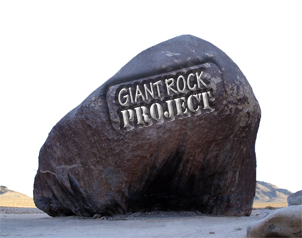 |
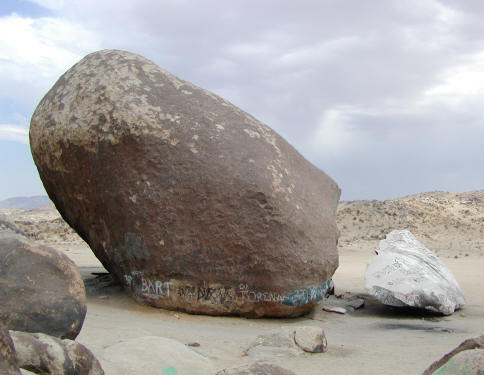 |
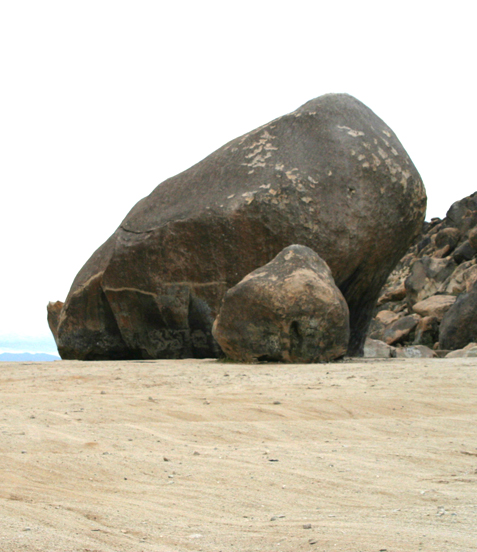 |
 |
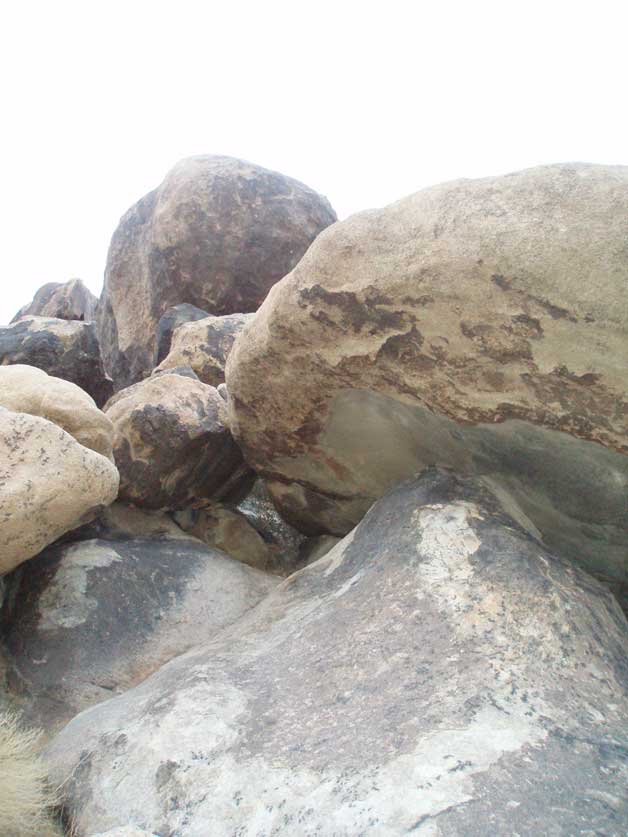 |
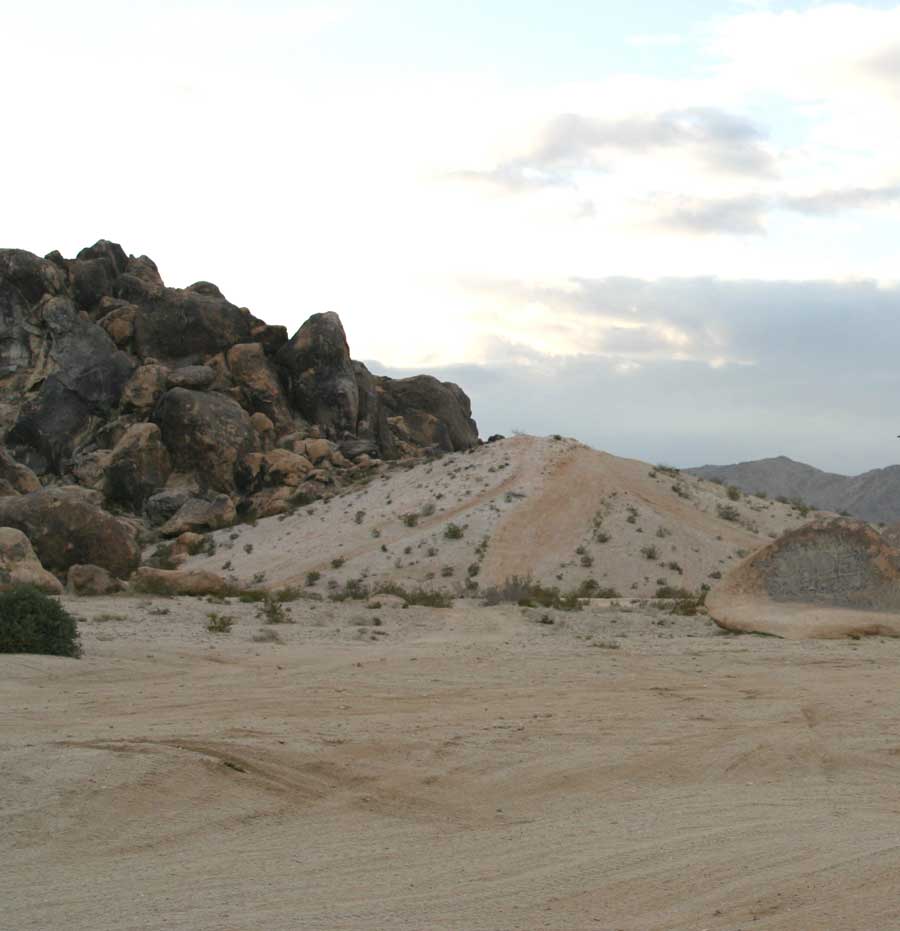 |
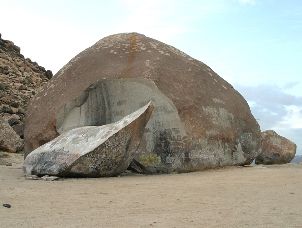 |
 |